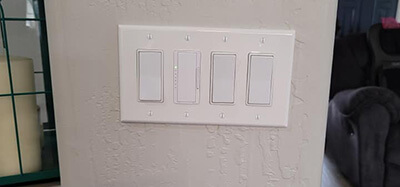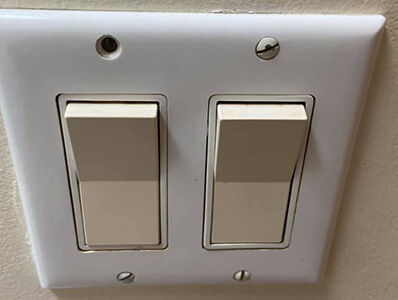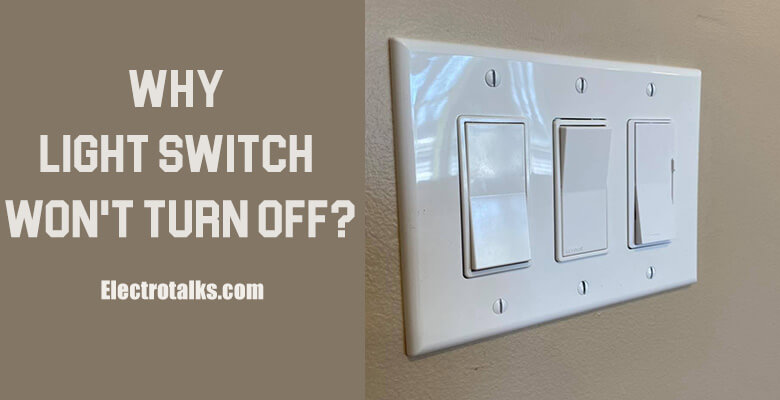“As an Amazon Associate, I earn from qualifying purchases. Without Any Extra Cost to You!”
A light switch is a device that allows you to turn on or off an electrical current to operate a light fixture, ceiling fan, or other electrical equipment.
There are times when the switch stops working without a valid reason. This should not stress you up as this article will guide you on all you require.
The switch can be tested with a voltage tester, which can be helpful if there are many wires in the electrical panel and you’re not sure if the issue is caused by a wiring problem or a bad switch.
The testing equipment required for this procedure is not a contact tester but rather one with two leads.
This article will explain more on what to do when this happens. The article includes why the light switch may stop working and what to do when this happens.
It consists of some of the most frequently asked questions. Keenly follow the article to get a better understanding.
Tools required
- A circuit tester
- Electrical tape
- Voltage tester
Reasons why a light switch won’t turn off

1. Possibility of a broken mechanism
Whenever a light switch fails to operate, it is frequently due to a malfunctioning mechanism. Most of the time, replacing the light switch is the only way to get out of a sticky situation.
According to the manufacturer, no matter how much time you flick the switch, the light will not turn on, and the switch head will not stay in position if you are dealing with a malfunctioning mechanism.
2. A fuse burnout
It is also possible for light switches to malfunction due to fuse burnout or tripped circuit breakers.
As a result, it’s critical to examine the circuit breaker before purchasing a new light switch in general. It is possible to rectify the situation by just replacing a fuse.
A caveat should be mentioned, however. A reassessment of how much energy you use might be necessary if you realize that you frequently have blown fuses. This will help you prevent overloading the electrical wiring.
3. Possibility of a loose wire
Flitting lights are a common complaint among those who are experiencing light switch issues. Occasionally, instead of the light switch, the problem is with the lightbulb.
If you’ve tightened your bulb but are still experiencing the flickering, the culprit may be a loose wire.
Unstuck wiring beneath the lighting switch plate is particularly prone to causing problems, and this is especially true in older homes.
4. A buzzing or a hot switch
Once you discover that your light switch is emitting a humming or even a buzzing sound, this could be a symptom of a more severe problem that needs to be addressed.
The same may be said for a switch too hot to touch when it is turned on. Even though the switch seems technically still operational, you may be exposing yourself to a fire hazard.
To avoid future problems, take care of the problem as soon as you can.
5. A faulty circuit wire
Using a circuit tester, you may check if your light switch is malfunctioning due to faulty connections made by the light switch itself.
If this is the case, you are most likely dealing with a damaged circuit cable and should seek the assistance of an electrician. While many tasks are doable without professional assistance, others necessitate it.
You may be interested in radio interference from light
Fixing a light switch

Step 1; ensure you gather all the required supplies
If you decide to take on the situation yourself, make sure you have all of the necessary supplies on hand.
Step 2; ensure safety.
Once you’ve gathered everything needed, take steps to safeguard yourself when handling electricity.
This includes shutting off the circuit breaker and turning off the light switch.
Make sure your cables are also capped and use electrical tape to designate the one you’ll be dealing with.
Step 3; spot the problem
Use a circuit tester to see if the problem is caused by faulty connections established by the light switch itself or if it is caused by something else entirely.
It is most likely that you are dealing with a damaged circuit cable and that you should seek the services of a professional electrical contractor.
Even while many chores may be completed without the assistance of a professional, others must be done so.
Step 4; replace your switch.
It’s possible that after you remove the light switch cover, you’ll discover that you’ll need to replace the switch based on the results of your inquiry.
There are only a few steps involved in this procedure. First and foremost, you’ll need to remove the light switch from the wall and store it somewhere safe.
Next, you’ll screw the new light switch into place using a screwdriver, taking care to make sure that all of the wires connecting to it are the same length as those already connected to the wall sockets.
Following the matching of all cables, you can screw the new light switch cover into position on the wall and turn the electricity on to complete the process.
Step 5; contact a professional
Do not hesitate to hire an electrician to address the problem if you are not sure of your ability to replace a light switch or handle any other component of this operation.
Mainly when dealing with electrical installations, it’s always better to err on the side of caution.
Frequently Asked Questions
Which is the most standard light switch?
The most straightforward, most popular light switch is called the “single-pole light switch” by hardware stores and electricians.
Single-pole light switches work by simply lifting the lever to connect a circuit and then letting it drop to disconnect it.
Conclusion
To conclude, if you discover that the light switch does not turn off soon after you have placed it, you have likely wired it incorrectly.
If the switch has been functioning correctly and you suddenly discover that the light remains on even when the switch is turned off, the controller is malfunctioning.
A disconnect between the toggle and the circuit terminals is most likely to blame for this problem. The most likely fault is that the cable going to the on-light contacts a live wire.
Disconnect all cables, switch on the breaker, then use a voltage tester to find the live circuit wire.
Wires for plugs and power may be tangled with the light fixtures. The other connections possibly supply electricity to other devices. Wear protective gloves.
If a wire is broken, feel it by touching it to the circuit wire. Once you’ve found the correct wire, switch it to the bottom terminal. If you can still fix your switch after following the steps, seek help from a knowledgeable person.
